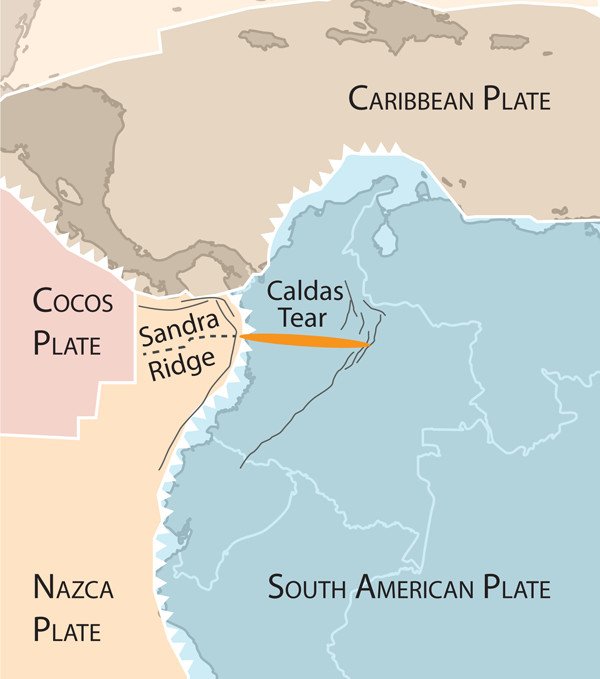
by Julia Rosen Friday, November 8, 2013

Four plates converge at the northwest corner of Colombia, leading to a complicated pattern of earthquake activity. Kathleen Cantner, AGI
Colombia sits atop a restless intersection of tectonic plates: The Caribbean Plate is subducting along the country’s northern coast while the oceanic Nazca Plate subducts along its western edge. In between, the narrow but buoyant Isthmus of Panama continues to crash into South America like a battering ram. The complex pattern of earthquake activity produced by these disparate forces has long confounded scientists hoping to decipher the plate structure beneath Colombia. In a new study, researchers have identified a feature called the Caldas Tear that may explain many long-standing riddles of Colombia’s geology.
The Caldas Tear, named for a town that lies along its trace, is an east-west break within the Nazca Plate that coincides with an old spreading ridge, wrote authors Carlos Vargas, a geophysicist at the Colombian National University in Bogota, and Paul Mann, a geologist at the University of Houston, in a recent study in the Bulletin of the Seismological Society of America. They suspect the tear formed as an indirect effect of the collision of the Panama microplate, which they call an “indenter” because it punches into the South American continent “like a fist,” Mann says. The indenter cannot subduct because it is composed of thick, buoyant crust — the remains of an ancient island arc — so it has instead caused widespread deformation. This deformation likely ripped apart the adjacent Nazca Plate along the reactivated spreading ridge.
Using a dataset of more than 100,000 recorded Colombian earthquakes, the scientists generated images of the plate structure beneath Earth’s surface based on differences in how seismic waves propagate through solid crustal slabs and molten mantle. The sharp edge of the Caldas Tear is clearly visible from these results, the authors wrote, and additional evidence for its existence can be found at the surface. Vargas and Mann cite the abrupt termination of the north-south chain of Andean volcanoes at the latitude of the tear, a zone marked by an anomalous east-west string of small volcanoes with unusual geochemical compositions and high-grade mineral deposits that support the idea that tectonic conditions change dramatically across the tear. The team says that strike-slip earthquakes along its trace, and changes in river morphology across the tear, suggest that it may propagate all the way to the surface. “You put all that [evidence] together and it says this is a major boundary,” Mann says.
Most importantly, the authors wrote, the tear represents a break between two zones of fundamentally different subduction mechanics. To the south, the Nazca Plate subducts at a steep angle typical of oceanic crust at convergent margins. This zone experiences regular moderate earthquakes and andesite volcanism, like the rest of South America’s west coast. North of the tear, however, the abnormally thick Panama and Caribbean Plates subduct at a very shallow angle, a feature confirmed by the study’s extensive tomographic imaging. Apart from along the tear itself, there is little seismic or volcanic activity in this region, except for an enigmatic cluster of deep earthquakes known as the Bucaramanga Nest.
“The Bucaramanga Nest is one of the densest swarms [of earthquakes] anywhere on the planet,” Mann says. Scientists have debated the cause of this seismicity for decades, but the new slab structure revealed in this study provides a possible explanation. “We’re proposing that the shallow part of the [Caribbean] slab is having problems going down,” Mann says. “But the part that’s already gone down wants to keep going under the force of gravity.” As a result, he says, deep sections of the slab can break off and fall into the mantle, causing intense seismic activity like that recorded over the Bucaramanga Nest. The location of the earthquakes matches where the down-going portion of the Caribbean Plate should be according to the scientists’ hypothesized slab geometry.
The Bucaramanga Nest is already a well-recognized source of seismic hazard, but Mann says that he hopes this study will highlight other regions of Colombia at risk for serious, shallow earthquakes. In the north, where there have been no large earthquakes in recorded history, Mann says the conditions are “similar to Cascadia [in the American Northwest] where there is relatively slow subduction but the potential for big, infrequent earthquakes.” In addition, the collision of Panama appears to have isolated a large wedge in the northwest corner of the country bounded by a series of large strike-slip faults, including one along the Caldas Tear itself. “There are cities everywhere that are threatened by these faults,” Mann says.
However, not everyone agrees with Vargas and Mann’s conclusions. “The interpretation presented [here] of a ‘Caldas Tear’ is an incorrect new interpretation that implies a single torn subducting plate,” says James Kellogg, a geologist who heads the Andean Geophysical Laboratory at the University of South Carolina and has worked extensively on Colombian tectonics. Although he thinks the new plate structure presented in this study is accurate, he favors “the previous interpretations with the Caldas feature as the southern edge of the Caribbean Plate overlying the Nazca Plate,” noting that many other studies came to this conclusion.
Mann says, however, that the evidence is too strong to suggest anything but a tear, and sees no signs of overlapping slabs beneath Colombia. He points to the important role of the Panama indenter in generating this unique geologic feature and says he hopes that further research will illuminate other ways that the indenter has impacted the geologic development of Colombia.
© 2008-2021. All rights reserved. Any copying, redistribution or retransmission of any of the contents of this service without the expressed written permission of the American Geosciences Institute is expressly prohibited. Click here for all copyright requests.